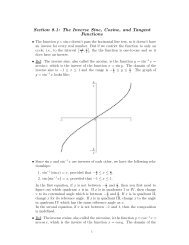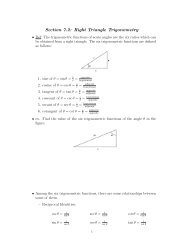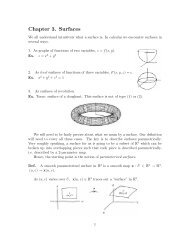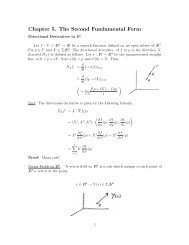Section 8.1: The Inverse Sine, Cosine, and Tangent Functions
Section 8.1: The Inverse Sine, Cosine, and Tangent Functions
Section 8.1: The Inverse Sine, Cosine, and Tangent Functions
Create successful ePaper yourself
Turn your PDF publications into a flip-book with our unique Google optimized e-Paper software.
<strong>Section</strong> <strong>8.1</strong>: <strong>The</strong> <strong>Inverse</strong> <strong>Sine</strong>, <strong>Cosine</strong>, <strong>and</strong> <strong>Tangent</strong><br />
<strong>Functions</strong><br />
• <strong>The</strong> function y = sin x doesn’t pass the horizontal line test, so it doesn’t have<br />
an inverse for every real number. But if we restrict the function to only on<br />
cycle; i.e., to the interval [ −π<br />
, ] π<br />
2 2 , the the function is one-to-one <strong>and</strong> so it<br />
does have an inverse.<br />
• Def: <strong>The</strong> inverse sine, also called the arcsine, is the function y = sin −1 x =<br />
arcsin x, which is the inverse of the function x = sin y. <strong>The</strong> domain of the<br />
inverse sine is −1 ≤ x ≤ 1 <strong>and</strong> the range is − π ≤ y ≤ π . <strong>The</strong> graph of<br />
2<br />
2<br />
y = sin −1 x looks like:<br />
• Since sin x <strong>and</strong> sin −1 x are inverses of each other, we have the following relationships:<br />
1. sin −1 (sin x) = x, provided that − π 2 ≤ x ≤ π 2 .<br />
2. sin ( sin −1 x ) = x, provided that −1 ≤ x ≤ 1.<br />
In the first equation, if x is not between − π <strong>and</strong> π , then you first need to<br />
2 2<br />
figure out which quadrant x is in. If x is in quadrants I or IV, then change<br />
x to its coterminal angle which is between − π <strong>and</strong> π . If x is in quadrant II,<br />
2 2<br />
change x for its reference angle. If x is in quadrant III, change x to the angle<br />
in quadrant IV which has the same reference angle as x.<br />
In the second equation, if x is not between −1 <strong>and</strong> 1, then the composition<br />
is undefined.<br />
• Def: <strong>The</strong> inverse cosine, also called the arccosine, is the function y = cos −1 x =<br />
arccos x, which is the inverse of the function x = cos y. <strong>The</strong> domain of the<br />
1
inverse cosine is −1 ≤ x ≤ 1 <strong>and</strong> the range is 0 ≤ y ≤ π. <strong>The</strong> graph of<br />
y = cos −1 x looks like:<br />
• Since cos x <strong>and</strong> cos −1 x are inverses of each other, we have the following<br />
relationships:<br />
1. cos −1 (cos x) = x, provided that 0 ≤ x ≤ π.<br />
2. cos (cos −1 x) = x, provided that −1 ≤ x ≤ 1.<br />
In the first equation, if x is not between 0 <strong>and</strong> π, then you first need to figure<br />
out which quadrant x is in. If x is in quadrants I or II, then change x to its<br />
coterminal angle which is between 0 <strong>and</strong> π. If x is in quadrant III, change x<br />
to the angle in quadrant II which has the same reference angle as x. If x is<br />
in quadrant IV, then change x for its reference angle.<br />
In the second equation, if x is not between −1 <strong>and</strong> 1, then the composition<br />
is undefined.<br />
• Def: <strong>The</strong> inverse tangent, also called the arctangent, is the function y =<br />
tan −1 x = arctan x, which is the inverse of the function x = tan y. <strong>The</strong><br />
domain of the inverse tangent is −∞ < x < ∞ <strong>and</strong> the range is − π < y < π.<br />
2 2<br />
<strong>The</strong> graph of y = tan −1 x looks like:<br />
2
• Since tan x <strong>and</strong> tan −1 x are inverses of each other, we have the following<br />
relationships:<br />
1. tan −1 (tan x) = x, provided that − π 2 < x < π 2 .<br />
2. tan (tan −1 x) = x, provided that −∞ < x < ∞.<br />
In the first equation, if x is not between − π <strong>and</strong> π , then you first need to<br />
2 2<br />
figure out which quadrant x is in. If x is in quadrants I or IV, then change<br />
x to its coterminal angle which is between − π <strong>and</strong> π . If x is in quadrant<br />
2 2<br />
II then change x to the angle in quadrant IV which has the same reference<br />
angle as x. If x is in quadrant III, then change x for its reference angle.<br />
• ex. Find the exact value of each expression.<br />
( √2 )<br />
(a) cos −1<br />
2<br />
(b) tan −1 ( − √ 3 )<br />
• ex. Find the exact value, if any, of each expression.<br />
(a) sin [ −1 sin ( )]<br />
3π<br />
5<br />
3
(b) sin [ sin ( )]<br />
−1 3<br />
10<br />
(c) cos −1 [ cos ( − 3π 4<br />
)]<br />
(d) cos [cos −1 (π)]<br />
(e) tan [ −1 tan ( )]<br />
11π<br />
5<br />
4
<strong>Section</strong> 8.2: <strong>The</strong> inverse Trigonometric <strong>Functions</strong><br />
(Continued)<br />
• Def: <strong>The</strong> inverse secant, also called the arcsecant, is the function y = sec −1 x =<br />
arcsec x, which is the inverse of the function x = sec y. <strong>The</strong> domain of the<br />
inverse secant is (−∞, 1] ∪ [1, ∞) <strong>and</strong> the range is [ 0, π 2<br />
)<br />
∪<br />
( π<br />
2 , π] .<br />
• Def: <strong>The</strong> inverse cosecant, also called the arccosecant, is the function y =<br />
csc −1 x = arccsc x, which is the inverse of the function x = csc y. <strong>The</strong> domain<br />
of the inverse cosecant is (−∞, 1] ∪ [1, ∞) <strong>and</strong> the range is [ − π 2 , 0) ∪ ( 0, π 2<br />
]<br />
.<br />
• Def: <strong>The</strong> inverse cotangent, also called the arccotangent, is the function<br />
y = cot −1 x = arccot x, which is the inverse of the function x = tan y. <strong>The</strong><br />
domain of the inverse tangent is −∞ < x < ∞ <strong>and</strong> the range is 0 < y < π.<br />
• Note: <strong>The</strong> inverse of a trig function is asking what angle in the domain would<br />
be needed to give the trig value the given value. So to find the exact value<br />
of a trig expression involving a trig function composed with an inverse trig<br />
function which are not inverses of each other, use the inverse trig function to<br />
draw a right triangle <strong>and</strong> use the triangle to solve the problem.<br />
• ex. Find the exact value of each expression.<br />
(a) tan [ cos ( )]<br />
−1 − 1 3<br />
(b) sec [ cos −1 ( − 3 4<br />
)]<br />
1
(c) sin −1 ( cos 3π 4<br />
)<br />
(d) cot ( csc −1 √ 10 )<br />
• ex. Write each trigonometric expression as an algebraic expression in u.<br />
(a) cos ( sin −1 u )<br />
(b) tan (csc −1 u)<br />
2
<strong>Section</strong> 8.3 (Previously <strong>Section</strong> 8.7 & 8.8):<br />
Trigonometric Equations<br />
• Recall that the period of sin x, cos x, csc x, & sec x is 2π <strong>and</strong> the period of<br />
tan x & cot x is π. Thus,<br />
θ (Degrees)<br />
sin (θ + 360 ◦ n) = sin θ<br />
cos (θ + 360 ◦ n) = cos θ<br />
tan (θ + 360 ◦ n) = tan θ<br />
csc (θ + 360 ◦ n) = csc θ<br />
sec (θ + 360 ◦ n) = sec θ<br />
cot (θ + 360 ◦ n) = cot θ<br />
θ (Radians)<br />
sin (θ + 2πn) = sin θ<br />
cos (θ + 2πn) = cos θ<br />
tan (θ + 2πn) = tan θ<br />
csc (θ + 2πn) = csc θ<br />
sec (θ + 2πn) = sec θ<br />
cot (θ + 2πn) = cot θ<br />
• ex. Solve each equation on the interval 0 ≤ θ < 2π.<br />
(a) sin (2θ) + 1 = 0<br />
(b) sec 2 θ = 4<br />
1
(c) 4 sin 2 θ − 3 = 0<br />
(d) cos ( θ<br />
− ) π<br />
3 4 =<br />
1<br />
2<br />
• ex. Give a general formula for all the solutions. List six solutions.<br />
(a) cos θ = 1 2<br />
(b) cot θ = 1<br />
(c) sin (2θ) = − 1 2<br />
• ex. Solve each equation on the interval 0 ≤ θ < 2π.<br />
(a) 2 sin 2 θ − 3 sin θ + 1 = 0<br />
2
(b) 8 − 12 sin 2 θ = 4 cos 2 θ<br />
(c) 1 + √ 3 cos θ + cos (2θ) = 0<br />
(d) sin θ − √ 3 cos θ = 2<br />
3
<strong>Section</strong> 8.4 (Previously <strong>Section</strong> 8.3): Trigonometric<br />
Identities<br />
• ex. Establish each identity.<br />
(a) tan θ cot θ − sin 2 θ = cos 2 θ<br />
(b)<br />
cos θ<br />
cos θ−sin θ = 1<br />
1−tan θ<br />
1
(c) 1 − sin2 θ<br />
1+cos θ = cos θ<br />
(d) csc θ − sin θ = cos θ cot θ<br />
2
<strong>Section</strong> 8.5 (Previously <strong>Section</strong> 8.4): Sum <strong>and</strong> Difference<br />
Formulas<br />
• <strong>The</strong>orem (Sum <strong>and</strong> Difference Formulas)<br />
1. sin (x + y) = sin x cos y + cos x sin y<br />
2. sin (x − y) = sin x cos y − cos x sin y<br />
3. cos (x + y) = cos x cos y − sin x sin y<br />
4. cos (x − y) = cos x cos y + sin x sin y<br />
5. tan (x + y) = tanx+tan y<br />
6. tan (x − y) =<br />
1−tan x tan y<br />
tan x−tan y<br />
1+tan x tan y<br />
• ex. Find the exact value of each expression.<br />
(a) cos 15 ◦<br />
(b) tan 75 ◦<br />
(c) sin 165 ◦<br />
(d) sec 105 ◦<br />
(e) csc ( )<br />
11π<br />
12<br />
1
(f) cot ( )<br />
− 5π<br />
12<br />
• ex. Find the exact value of (a) sin (x + y), (b) cos (x + y), (c) tan (x − y)<br />
given that<br />
sin x = − 3 5 , π < x < 3π 2<br />
; cos y =<br />
12<br />
13 , 3π<br />
2 < y < 2π<br />
• ex. Establish each identity.<br />
(a) sin (π + θ) = − sin θ<br />
2
(b)<br />
sin (x−y)<br />
sin x cos y<br />
= 1 − cot x tan y<br />
• ex. Find the exact value of each expression.<br />
(a) cos ( sin −1 3 − )<br />
5 cos−1 1 2<br />
(b) tan [ sin ( ]<br />
−1 − 2) 1 − tan<br />
−1 3<br />
4<br />
3
<strong>Section</strong> 8.6 (Previously <strong>Section</strong> 8.5): Double-angle <strong>and</strong><br />
Half-angle Formulas<br />
• <strong>The</strong>orem (Double-angle Formulas)<br />
1. sin (2θ) = 2 sin θ cos θ<br />
2. cos (2θ) = cos 2 θ − sin 2 θ<br />
3. cos (2θ) = 1 − 2 sin 2 θ<br />
4. cos (2θ) = 2 cos 2 θ − 1<br />
5. tan (2θ) = 2 tan θ<br />
1−tan 2 θ<br />
• Note: Formulas 1, 2, <strong>and</strong> 5 can be obtained from the Sum Formulas from<br />
the previous section by setting x = θ <strong>and</strong> y = θ. Formulas 3 <strong>and</strong> 4 can be<br />
obtained from formula 2 by using the Pythagorean Identity sin 2 θ+cos 2 θ = 1.<br />
In formula 3, solve the Pythagorean Identity for cos 2 θ <strong>and</strong> plugging it into<br />
formula 2. In formula 4, solve the Pythagorean Identity for sin 2 θ <strong>and</strong> plugging<br />
it into formula 2.<br />
• From the Double-angle formulas, we can get formulas for the square of the<br />
trig functions.<br />
1. sin 2 θ =<br />
2. cos 2 θ =<br />
3. tan 2 θ =<br />
1−cos (2θ)<br />
2<br />
1+cos (2θ)<br />
2<br />
1−cos (2θ)<br />
1+cos (2θ)<br />
• In the previous set of formulas for the square of the trig functions, if we<br />
replace each θ by φ , we get the following formulas:<br />
2<br />
1. sin 2 φ 2 = 1−cos φ<br />
2<br />
2. cos 2 φ 2 = 1+cos φ<br />
2<br />
3. tan 2 φ 2 = 1−cos φ<br />
1+cos φ<br />
• <strong>The</strong>orem (Half-angle Formulas)<br />
1. sin θ 2 = ± √<br />
1−cos θ<br />
2<br />
2. cos θ 2 = ± √<br />
1+cos θ<br />
2<br />
3. tan θ 2 = ± √<br />
1−cos θ<br />
1+cos θ<br />
4. tan θ 2 = 1−cos θ<br />
sin θ<br />
5. tan θ 2 = sin θ<br />
1+cos θ<br />
where the + or − sign is determined by the quadrant in which the angle θ 2<br />
lies in.<br />
1
• ex. Find (a) cos (2θ), (b) sin θ given that<br />
2<br />
sin θ = − 3 5 , π < θ < 3π 2<br />
• ex. Find the exact value of each expression.<br />
(a) cos 15 ◦<br />
(b) tan π 8<br />
• ex. Establish each identity.<br />
(a) 2 sin (2θ) cos (2θ) = sin (4θ)<br />
2
(b) sin (3θ) = 3 sin θ − 4 sin 3 θ<br />
• ex. Find the exact value of each expression.<br />
(a) sin ( )<br />
1<br />
2 cos−1 3 5<br />
(b) tan ( )<br />
2 sin −1 6<br />
11<br />
3
<strong>Section</strong> 8.7 (Previously <strong>Section</strong> 8.6): Product-to-Sum<br />
<strong>and</strong> Sum-to-Product Formulas<br />
• <strong>The</strong>orem (Product-to-Sum Formulas)<br />
1. sin x sin y = 1 [cos (x − y) − cos (x + y)]<br />
2<br />
2. cos x cos y = 1 [cos (x − y) + cos (x + y)]<br />
2<br />
3. sin x cos y = 1 [sin (x + y) + sin (x − y)]<br />
2<br />
• <strong>The</strong>orem (Sum-to-Product Formulas):<br />
1. sin x + sin y = 2 sin x+y cos x−y<br />
2 2<br />
2. sin x − sin y = 2 sin x−y cos x+y<br />
2 2<br />
3. cos x + cos y = 2 cos x+y cos x−y<br />
2 2<br />
4. cos x − cos y = −2 sin x+y sin x−y<br />
2 2<br />
• ex. Express each product as a sum containing only sines or only cosines.<br />
(a) sin (3θ) sin (4θ)<br />
(b) cos (3θ) cos (2θ)<br />
(c) sin ( ) (<br />
θ<br />
2 cos 3θ<br />
)<br />
2<br />
• ex. Express each sum or difference as a product of sines <strong>and</strong>/or cosines.<br />
(a) sin 2θ + sin (4θ)<br />
(b) cos (5θ) + cos θ<br />
1
(c) cos ( ) (<br />
θ<br />
2 − cos 5θ<br />
)<br />
2<br />
• ex. Establish each identity.<br />
(a)<br />
sin (2θ)+sin (4θ)<br />
cos (2θ)+cos (4θ)<br />
= tan (3θ)<br />
(b) sin θ [sin (3θ) + sin (5θ)] = cos θ [cos (3θ) − cos (5θ)]<br />
2








